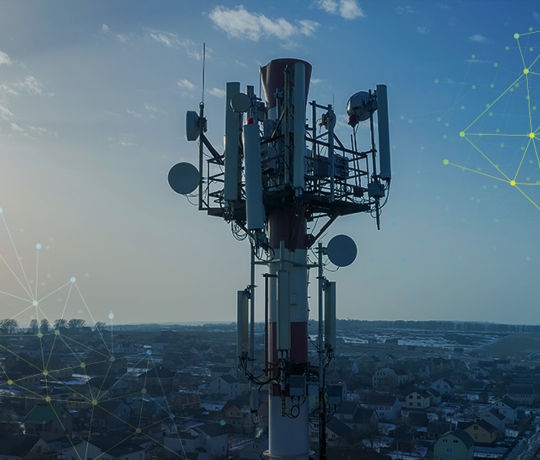Search results
The newly available C-band frequencies are considered ideal for 5G as they strike the perfect balance between coverage and throughput. As those frequencies weren’t available when 5G was first introduced, operators are now realigning their investments to focus on C-band in an effort to offer a quicker, better 5G experience to mobile users. This new mid-band spectrum enables mobile and broadband providers to expand their services, such as the ability to provide fast home internet service in rural areas via fixed wireless access (FWA). Yet, C-band imposes new RF technologies and requirements, making 5G network deployments complex for operators. In this webinar, we will focus on some of the key technologies and important considerations for efficiently validating 5G C-band deployments—all through the lens of a real-world use case. Key topics include: what is C-band and what role does it play in 5G how will C-band help to accelerate 5G roll outs what are the new testing best practices for validating 5G C-band deployments throughout the network lifecycle
Resources5G promete revolucionar la forma en que operan las redes móviles. Capacidades como 1 Gbit / s para el dispositivo, latencia de 1 ms y disponibilidad de cinco 9’s proporcionan una oportunidad sin igual para la innovación de servicios. En 5G la fibra es la respuesta para llevar las comunicaciones al siguiente nivel, sin embargo, muchos problemas de servicio que impactarán estas redes se remontan a problemas de calidad en un cable de fibra. Tener el equipo de prueba adecuado para detectar y diagnosticar rápidamente problemas es esencial para una resolución rápida. 5G no ser á la excepción; de hecho, dada la tendencia hacia un mayor ancho de banda y mejor calidad de señal, muchos parámetros que no afectan las redes existentes se harán notar a medida que se exigen mejoren rendimientos operativos en las nuevas tecnologías a ser implementadas Acompáñenos a esta serie de cuatro seminarios web para EXFO será un honor que nos permita mostrarle las opciones de equipos de medición y metodologías que ofrecemos; queremos ser su mejor aliado al momento de ejecutar o resolver sus problemas, donde sea que una red de alta velocidad sea desplegada. Sesión 3 - 14 julio | Sincronía: Conceptos básicos y parámetros que deben ser vigilados y medidos en redes de telecomunicaciones Sesión 4 - 28 julio | Monitoreo de enlaces Ópticos (L1) de redes de alta velocidad: El crecimiento masivo de enlaces de fibra óptica obliga a contar con un monitoreo 24/7 para la detección y ubicación inmediata de daños en la infraestructura.
Resources5G promete revolucionar la forma en que operan las redes móviles. Capacidades como 1 Gbit / s para el dispositivo, latencia de 1 ms y disponibilidad de cinco 9’s proporcionan una oportunidad sin igual para la innovación de servicios. En 5G la fibra es la respuesta para llevar las comunicaciones al siguiente nivel, sin embargo, muchos problemas de servicio que impactarán estas redes se remontan a problemas de calidad en un cable de fibra. Tener el equipo de prueba adecuado para detectar y diagnosticar rápidamente problemas es esencial para una resolución rápida. 5G no ser á la excepción; de hecho, dada la tendencia hacia un mayor ancho de banda y mejor calidad de señal, muchos parámetros que no afectan las redes existentes se harán notar a medida que se exigen mejoren rendimientos operativos en las nuevas tecnologías a ser implementadas Acompáñenos a esta serie de cuatro seminarios web para EXFO será un honor que nos permita mostrarle las opciones de equipos de medición y metodologías que ofrecemos; queremos ser su mejor aliado al momento de ejecutar o resolver sus problemas, donde sea que una red de alta velocidad sea desplegada. Sesión 4 - 28 julio | Monitoreo de enlaces Ópticos (L1) de redes de alta velocidad: El crecimiento masivo de enlaces de fibra óptica obliga a contar con un monitoreo 24/7 para la detección y ubicación inmediata de daños en la infraestructura.
ResourcesJoin EXFO and Electro Rent for our 5G Fronthaul Validation webinar. This seminar will cover the steps for Fronthaul link validation using an EXFO test module. In this course, we will discuss Connector Performance, Fiber Characterization, Backhaul Link Validation, CPRI/eCPRI Link Validation, and Transceiver Health Check. Identify, understand, and test the 5-step process for Fronthaul link validation: Connector performance Fiber Characterization VLAN validation CPRI/eCPRI Link validation Transceiver health check
ResourcesThe only way for operators to generate more revenue is to take more risk. The promise of 5G networks is in selling augmented connectivity solutions to enterprises, and not to consumers. But the operator community must guarantee 5G services, offered on network slices or in private instances, if they are to win business from the digital transformation of the enterprise sector. But how far will operators go to guarantee critical operations against security threats and 5G blackouts? Speakers: James Blackman, Editor, Enterprise IoT Insights Shubh Agarwal, SVP of 5G, Metaswitch Dheeraj Remella, Chief Product Officer, VoltDB Guillaume Briand, Product Line Manager, EXFO Leo Gergs, Research Analyst, ABI Research Vassilis Seferidis, CEO, Zeetta Networks Limited
ResourcesLos invitamos a esta serie de dos seminarios web, donde abordaremos la importancia de la validación de la infraestructura óptica y la transmisión de información en Centros de Datos. La disponibilidad de los Centros de Datos es fundamental. Hoy en día, tiempos muy largos de afectación suponen gastos descomunales, por lo que las instalaciones deben ser en extremo confiables. En EXFO, estamos comprometidos a ayudar a todos nuestros clientes, para que puedan ofrecer la mejor calidad de servicio y experiencia posible en sus Centros de Datos. Acompáñenos a estos 2 seminarios web. Para nosotros será un honor que nos permita mostrarle las opciones de equipos de medición y metodologías que ofrecemos, queremos ser su mejor aliado al momento de ejecutar la resolución de sus problemas, donde sea que haya fibra. Sesión 1- Mediciones de enlaces ópticos en Centros de Datos - 19 mayo. En este seminario web usted conocerá las pruebas necesarias para asegurar el correcto estado de los enlaces ópticos “intra/entre” Centros de Datos. Sesión 2 - Validación de enlaces de datos dentro y fuera del Centros de Datos, el mundo después de 10G - 2 junio. Conocerá en este seminario web las pruebas capa 2, 3 y 4 necesarias en la validación de enlaces Ethernet “intra/entre” Centros de Datos.
ResourcesFiber has become a critical element in delivering high-quality broadband and 5G networks. Driven by new bandwidth-intensive applications and more demanding customer expectations, fiber is being pushed beyond the core and aggregation networks – all the way to the end customer or cell tower. And the mission-critical nature of many of these services is driving the need for greater visibility to support stringent SLA requirements. Today, it is estimated that less than 5% of fiber is actively monitored – and as data rates and wavelength counts increase, the impact of fiber quality issues is magnified. This is especially true not only for new fiber builds where it is estimated that at least 30% of the fibers will have service-impacting issues, but equally for older fiber infrastructure that was never expected to support the increased data rates. Today’s networks, which rely heavily on automation to reduce opex, need complete visibility into customer quality of experience (QoE) and network quality of service (QoS). And while much of this can be provided through active assurance monitoring at layers 2 through 7, the full benefits of this automation requires visibility down to the optical layer. This complete visibility can significantly reduce opex by minimizing the need for truck-rolls by pinpointing the exact location of service-impacting issues and correlating fiber monitoring KPIs with active assurance KPIs to quickly identify root cause events, shorten MTTR and, when combined with machine learning, predict service-impacting events before they happen. Join this webinar to learn how Hyperoptic and Mox Networks are using fiber monitoring to: Speed up deployment of new fiber networks by fully testing and characterizing all fibers and splitters while the construction teams are still on site Speed up the time-to-first revenue and improve overall customer experience through improved network quality Reduce operations costs and speed up time-to-revenue by automating the turnup and testing of dark and lit fiber services
Resources5G promete revolucionar la forma en que operan las redes móviles. Capacidades como 1 Gbit / s para el dispositivo, latencia de 1 ms y disponibilidad de cinco 9’s proporcionan una oportunidad sin igual para la innovación de servicios. En 5G la fibra es la respuesta para llevar las comunicaciones al siguiente nivel, sin embargo, muchos problemas de servicio que impactarán estas redes se remontan a problemas de calidad en un cable de fibra. Tener el equipo de prueba adecuado para detectar y diagnosticar rápidamente problemas es esencial para una resolución rápida. 5G no ser á la excepción; de hecho, dada la tendencia hacia un mayor ancho de banda y mejor calidad de señal, muchos parámetros que no afectan las redes existentes se harán notar a medida que se exigen mejoren rendimientos operativos en las nuevas tecnologías a ser implementadas Acompáñenos a esta serie de cuatro seminarios web para EXFO será un honor que nos permita mostrarle las opciones de equipos de medición y metodologías que ofrecemos; queremos ser su mejor aliado al momento de ejecutar o resolver sus problemas, donde sea que una red de alta velocidad sea desplegada. Sesión 1 - 16 junio | La importancia de medir la capa física en 5G: La fibra óptica, medio que respaldará a 5G, para lograr los niveles de latencia y ancho de banda necesarios. ¿Qué pruebas deben ejecutarse para garantizar el buen estado del enlace de esta capa física? Sesión 2 - 30 junio | SLAs al más alto nivel, cómo saber que sí cumples con ellos: ¿Qué parámetros y qué pruebas debes ejecutar? Se trata de los SLAs más exigentes que hemos conocido en enlaces masivos hacia el usuario final. Sesión 3 - 14 julio | Sincronía: Conceptos básicos y parámetros que deben ser vigilados y medidos en redes de telecomunicaciones Sesión 4 - 28 julio | Monitoreo de enlaces Ópticos (L1) de redes de alta velocidad: El crecimiento masivo de enlaces de fibra óptica obliga a contar con un monitoreo 24/7 para la detección y ubicación inmediata de daños en la infraestructura.
ResourcesOverview “5G will be the game changer” was the buzz phrase we heard during the past several years. Communications Service Providers (CSPs), who were first out of the gate to deploy 5G, however, experienced only bitter lessons in sharing RAN, Transport, and 4G Core. Even today, CSPs are still seeking ways to monetize 5G infrastructure in an effort to pave the way for return on their million-dollar investments in the 5G infrastructure while overcoming challenges that risk delaying revenue. Watch this webinar to learn how 5G standalone (SA)—in contrast to 5G non-standalone architecture (NSA)—will blaze new grounds and enable addressing new target markets and, eventually, create new revenue streams. This webinar will focus on designing and deploying an end-to-end 5G network, including RAN, Transport, Core network, network analytics, and orchestration, to win the actual 5G race. We will also discuss how 5G SA shared cloud infrastructure helps mitigate risks, improves network performance for innovative use cases, and increases monetization for service providers. Key Topics for Discussion 5G standalone architecture (SA) network design transformation discussion on E2E network, including RAN-Transport and Core How 5G SA can meet the requirements of future innovative use cases Role of 5G core and multi-layer slicing and orchestration for latency-sensitive applications Support of core function to the network edges to enable URLLC services How service assurance supports the complex deployment journey, and enables closed-loop control Answers to audience questions during live Q&A Speakers Sameer Malik, Senior Principal Analyst, Service Provider Routing and Switching, Omdia Dudy Cohen, Senior Director, Product Marketing, DriveNets Scott Sumner, Director, Commercial Insight, EXFO Allen Tatara, Associate Director, Omdia Webinars (Moderator)
ResourcesNetwork equipment manufacturers (NEMs) and optical R&D labs are facing growing challenges related to global network transformations including 5G mobility, high-speed broadband, data centers and edge networking. In this fast-paced and complex environment, NEMs and labs need scalable, agile testing solutions that meet evolving R&D and production requirements. To ensure high quality and cost-effectiveness, test & measurement solutions must leverage automation and advanced technology while ensuring that testing is done from end to end. In this webinar, Stephen Hardy from Lightwave will join EXFO expert Leo Lin to discuss industry trends and best practices around testing next-gen high speeds, optical components and photonic integrated circuits. The speakers will also share actionable insights that were gathered earlier this year during EXFO’s TEST Talks, an online series of panels with experts from across the industry. Key takeaways: Key trends and challenges in rolling out 400G/800G End-to-end testing solutions for R&D, manufacturing to field as well as component, module and system requirements Best practices and use cases with major industry players
Resources







